Hey there. Nicholas Martin (aka pest buster) here. Today, I’m going to talk about fruit flies. Oh yeah, those pesky uninvited guests are so tedious. Fruit flies invade your bedroom. They’re all over your kitchen. What’s most irritating is that they just love your food! You chase them down, Raid-ing them to death or whacking the heck out of them, but their buddies come back for more of your yummies… That’s just not fair!
Where do fruit flies come from all of a sudden? What exactly causes fruit flies? Are they dangerous? If these questions keep turning, churning, and burning inside you, you’ve come to the right place.
I’m a professional entomologist (read as fruit fly slayer). So in this post, I’m going to tell you all about your current buzzing enemies, arming you with all the details necessary for their elimination. This knowledge will help you eradicate your fruit fly infestation.
Fruit Fly Identification Guide: Spot the Foe
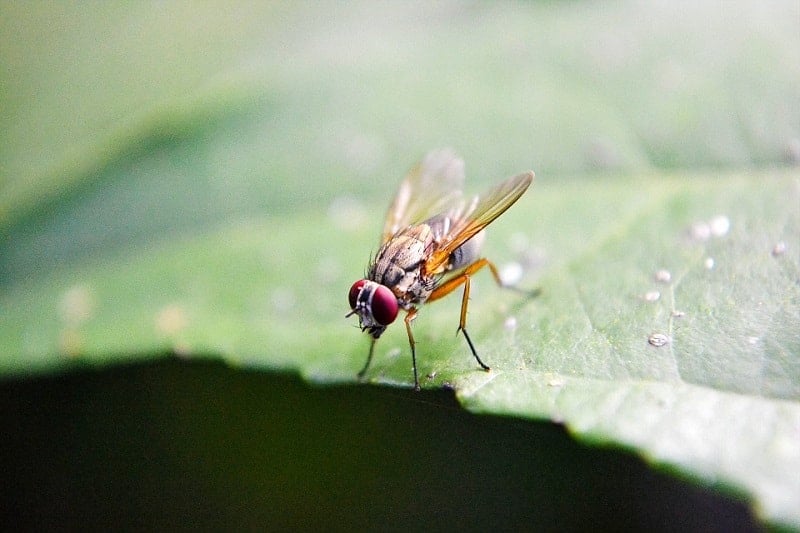
You’re probably aware that fruit flies adore hanging out where it’s warm and cozy. But why do they all of a sudden choose your house as their permanent place of residence? Do they just pop out of thin air?
Or do they come from fruit? What causes fruit flies? Where do fruit flies lay eggs? How long do fruit flies live? I’ll start answering all these questions from the very beginning.
Fruit flies (also referred to as vinegar, wine flies, or, in a more scientific language, ‘Drosophilae melanogaster’) look similar to house flies, but there are certain major distinctions.
Their color ranges from yellow to brown; they usually have reddish eyes (although there are dark-eyed fruit fly species), as well as thin, transparent wing covers. Adult drosophilae have noticeable antennae that look fluffy in an ugly way.

Fruit Flies vs. Fungus Gnats: Ok, What’s the Difference?
Wondering about the visual distinction between fruit flies and fungus gnats? They, indeed, look quite similar. Moreover, fruit flies and gnats even have similar behavior patterns. However, there are a few distinguishing features between these two tiny pests.
First and foremost, gnats usually have longer legs compared to drosophilae. Second, fruit flies have big, red eyes, while gnats’ eyes are so tiny that they are way too challenging to spot. Furthermore, gnats have longer bodies compared to fruit flies.
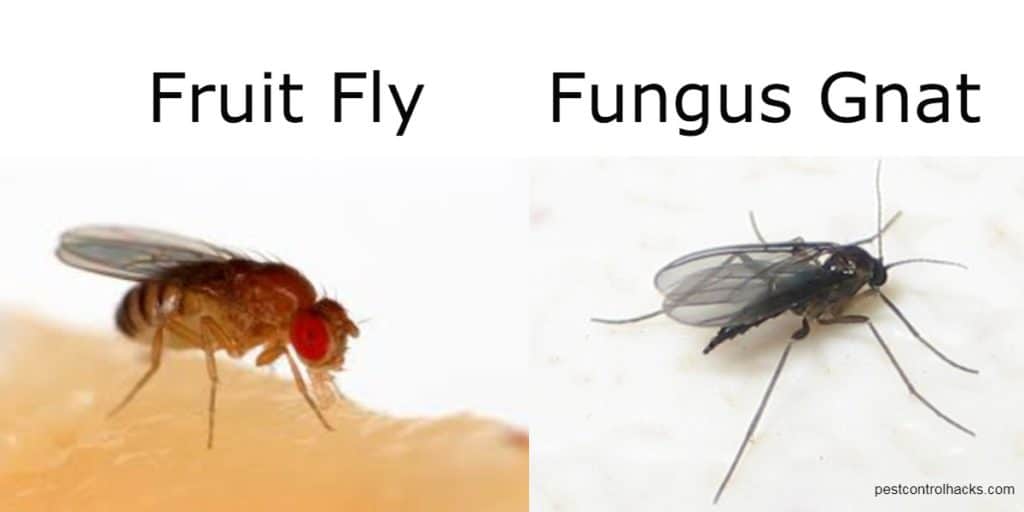
With regard to the differences in terms of their behavior, fungus gnats prefer using your garden soil (or the soil of your houseplants) as their nesting location. That’s why they’re alternatively referred to as soil gnats, by the way. As for fruit flies, they choose overripe fruit or drains as their breeding area.
If you’re wondering if drosophilae and fungus gnats are dangerous, well, they’re no good for your home for sure. Fruit flies, for instance, can spread a variety of bacteria and, i.e. cause health issues, while fungus gnats can damage your plants. So the faster you start getting rid of the problem, the faster you’ll deal with it.
How Fruit Flies Get in Your House
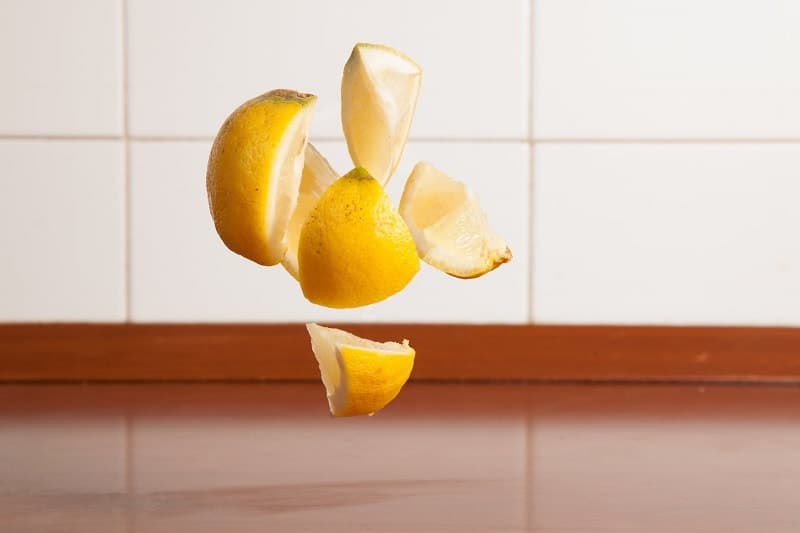
Fruit fly larvae are buttery-colored, thin, and rice grain-shaped. Pretty often, fruit flies lay their eggs in fermenting liquid (mainly inside your fruit or vegetables brought from the grocery store). As a matter of fact, spotting fruit fly eggs is barely possible.
Therefore, you can accidentally eat them (yuck!) each time you enjoy an apple or peach! So be sure to wash your fruit like a pro prior to munching on them…
You’ve probably already guessed that fruit flies don’t just pop out of nowhere, even though it seems like they do. They may enter your home through small cracks in your walls and even through tiny crevices around your windows.
Alternatively, you may bring their pre-laid eggs inside the fruit or veggies from your local grocery store. Hope that answers your ‘how do fruit flies get in the house’ question.
How Do Fruit Flies Reproduce? Impressively Rapid Transformation
Studying the life cycle of this nasty pest is useful for winning your fruit fly battle. Without this vital knowledge, you may end up failing to eradicate your drosophila problem. The whole life cycle of a fruit fly is quite short and takes only up to 1.5 months.
Their life span largely depends on the time of year, though. Fruit flies are the most lively and active during warmer months. ‘Lady’ fruit flies lay several clusters of eggs during that period, which allows the ‘community’ of these pests to multiply very speedily.
What’s astonishing about the life cycle of drosophilae is that their egg-to-adult fly metamorphosis takes no longer than 2 weeks. That’s astoundingly fast. Let’s track how exactly they do the trick of ‘flying’ from fetus into adulthood. I’ll describe the process and the stages below.
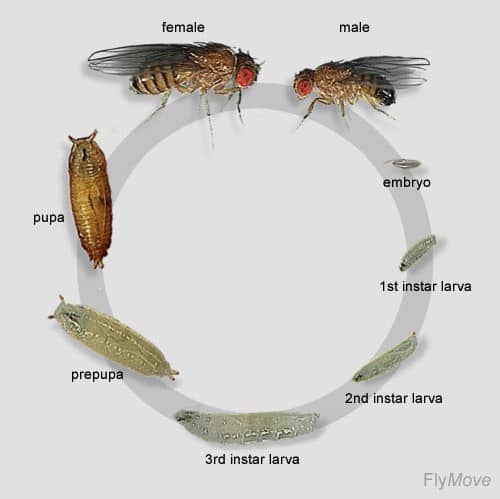
There are four distinct stages in the life cycle of a fruit fly. Here’s a brief outline of each of them:
- egg stage: the ‘lady’ fly lays up to 20 eggs that transform into larvae within about 2 days; at this point, fruit fly eggs are so tiny that you will probably fail to notice them on your fruit or veggies; throughout its lifetime, a mom drosophila is capable of laying up to 500 eggs;
- larva stage: at the larval stage (which lasts for up to 4 days), the egg has already transformed into maggots, also referred to as the larvae: short, small, food-loving worms. These worms stuff their fatty bodies with food until they are ready for the next stage of the fruit fly transformation;
- pupa stage: this stage is crucial when it comes to the fruit fly transformation; once it’s over, the fly is all grown up and more than ready to invade your sweet home with its pesky friends;
- adult drosophila stage: if all goes ‘as planned’ during the previous stage, at this point the egg-to-adult fly transformation is fully complete; that pretty much answers your ‘how are fruit flies born’ question; the adult fly is hungrier than ever, for the previous stage has drained of all of its resources.
If you’re wondering where all fruit flies go during the wintertime, they enter a state called diapause, which is the insect ‘sleep mode’. During this time, their growth and appetite are slowed down — right until the weather is warm, and they can munch on their favorite yummies again.
Why Do Fruit Flies Appear? More Answers to Your Questions Below
Drosophilae are toothless; therefore, liquids are their main food. Organic materials, including sugary ones, lure these bothersome creatures. Most frequently, these flies infest fruit, hence their ‘fruity’ name.
That’s mainly because fruit (especially when it rots) naturally gives off the sweet smell of honey and vinegar — something that fruit flies are totally hypnotized by.
If you go out of town and leave, say, ripe peaches on your kitchen table, a loud fruit fly party is definitely going to await you when you come back. Also, fruit flies can breed in rotting meat, trash cans, and soda/alcohol spills.
That’s why enjoying a glass of your favorite beer on a warm summer night is often impossible without being hunted by a swarm of the hovering uninvited guests.
Fruit Fly FAQ
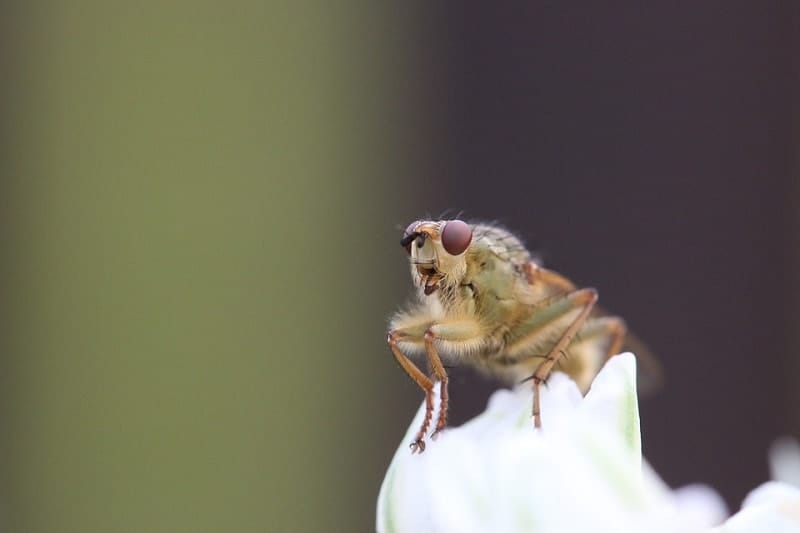
1. Do fruit flies come from fruit?
Not exactly. Fruit flies don’t just suddenly materialize from inside the fruit. On the contrary, these stealthy guys attack the fruit in your kitchen from outside — right when it’s all overripe and juicy. In other words, fruit flies that come from the fruit is a (pretty ridiculous) myth.
2. Where do fruit flies come from in the bathroom?
Drosophilae enjoy spending time in warm, moist places. Most frequently, they lay their eggs on the surface of ripe fruit and veggies. However, fruit fly moms can easily opt for any other dark, moist areas (like your shower or sink drains) for laying their eggs. Yep, that’s how easily clouds of nasty fruit flies in your bathroom can be explained.
3. How fast do fruit flies breed?
Drosophilae reproduce at an incredible rate. On average, all the aforementioned stages of the life cycle of a fruit fly take up no longer than one week. That being said, when an infestation begins, it usually races out of control inexplicably fast.
4. Can fruit flies come from drain?
Yes. Fruit flies can breed in sewers, drains, trash cans, septic tanks, under your bathroom sink, under a loose floor tile, and in similar non-typical areas. These pesky insects thrive on moisture and organic debris; therefore, the aforementioned locations are pretty comfy for their short yet very noticeable lives.
5. Are fruit flies dangerous to your health?
Fruit flies are not as hazardous as, say, wasps, but they’re still not just a mere annoyance. In fact, plenty of germs can stick to the bodies of fruit flies. These germs (gut bacteria in particular) can get on your food and cause such a highly unpleasant health problem as diarrhea.
6. Do fruit flies bite?
No. Fruit flies cannot flaunt biting mouthparts. Besides, they don’t care about your blood. All they care about is rotten fruit, trashcans, and nice booze. So in this sense, fruit flies are the direct opposites of mosquitoes.
7. Can fruit flies go away on their own?
Fruit flies are extremely fertile. They breed nonstop, laying up to 500 eggs throughout their short lifespan. Once these tenacious pests make themselves at home in your house, they will not go away on their own. Luckily, you don’t have to put up with them and can get rid of them either under your own steam or with professional assistance.
Also read:
- Best Electric Fly Swatter
- How to Get Rid of Horse Flies
- How to Get Rid of Crane Flies
- How to Get Rid of Cluster Flies
- How to Get Rid of Whiteflies
Last but Not Least: Knowledge Is Power
Now that you’ve learned all there is to know about drosophilae and their major habits, you’re armed with logical prevention steps against these little troublemakers.
First, have proper sanitation, clean up, or get rid of all their potential breeding spots. Second, make sure that your garbage bins have tight lids.
On top of that, make sure that you keep your fruit and veggies in the fridge. Your almost-rotten fruit should be discarded immediately. If you’re experiencing a fruit fly infestation that’s out of control, you’re welcome to research on the best fruit fly traps in one of my previous posts — or get in touch with licensed pest control pros asap.
What about your experience of overcoming fruit fly infestations? How did you solve the problem? Or are you still in the process of battling fruit flies? Feel free to share your opinion with me and your fellow-readers in the comment section below. Any feedback from my readers is always highly appreciated.
References:
- Fruit Flies (Entomology at the University of Kentucky):
https://entomology.ca.uky.edu/ef621 - An Introduction to Drosophila melanogaster (University of Washington):
https://depts.washington.edu/cberglab/wordpress/outreach/an-introduction-to-fruit-flies/

